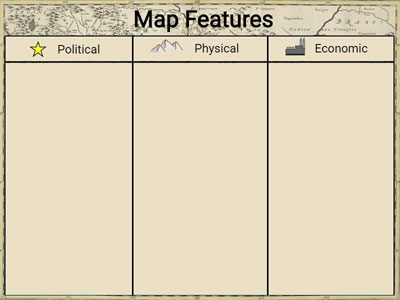

Students create maps to show the geographic features, regions, and economy of a state or region.
Collect examples of political maps, physical maps, economic and topographic maps and share with students.
Ask students to brainstorm the different things they see on the maps and work with them to find and identify the compass rose, scale, and legend.
Have students sort the sample maps into different groups depending on the features found on them. You can use the Map Features template to create an anchor chart that lists the features found on a political, physical, or economic map.
Then, let students know that they will be using their cartography knowledge and skills to create a political, physical, and economic map.
To get started, you can assign a map from the maps template folder or have students use a blank canvas to create their political, physical, or economic map. If creating from a blank canvas, students can navigate to the Maps sticker folder in the Image Library to find map outlines of each state or province.
Ask students to add:
The goals of your classroom will determine which type, or types, of maps your students create.
Hang the printed maps in groups by type so everyone can see them. Have students identify similarities and differences between the maps. Then, ask students to identify new information that they learned from other students’ maps and presentations.
Ducksters: Facts and information about each state (contains ads)
Color Landform Atlas of the US
Dimension 2: Geography
D2.Geo.1.3-5. Construct maps and other graphic representations of both familiar and unfamiliar places.
6. Creative Communicator
Students communicate clearly and express themselves creatively for a variety of purposes using the platforms, tools, styles, formats and digital media appropriate to their goals. Students:
a. choose the appropriate platforms and tools for meeting the desired objectives of their creation or communication.
b. create original works or responsibly repurpose or remix digital resources into new creations.
c. contribute constructively to project teams, assuming various roles and responsibilities to work effectively toward a common goal.
d. publish or present content that customizes the message and medium for their intended audiences.

